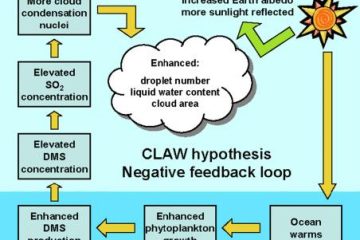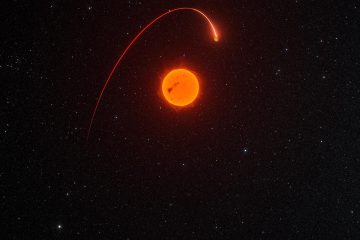Table of Contents
- Exploring the Principles of the Gaia Hypothesis
- The Interconnection of Life and Earth Systems
- Evidence Supporting the Gaia Hypothesis
- Implications for Environmental Policy and Sustainability
- Practical Steps to Embrace Gaias Insights in Daily Life
- Q&A
- To Wrap It Up
Exploring the Principles of the Gaia Hypothesis
The Gaia Hypothesis, formulated by James Lovelock in the 1970s, revolutionizes our understanding of Earth’s biological and physical systems. This concept proposes that life on Earth, in its vast complexity, interacts with the environment in a way that maintains conditions conducive to life. By viewing our planet as a self-regulating entity, the hypothesis underscores the interconnectedness of all living organisms and their surroundings. The underlying principle is that living beings, through activities such as respiration, excretion, and decomposition, play a crucial role in regulating vital environmental parameters like temperature and atmospheric composition.
Key principles of the hypothesis highlight the dynamic relationships among Earth’s systems. These principles include:
- Self-Regulation: Life influences the environment and vice versa, creating a balance that supports diverse ecosystems.
- Feedback Loops: Positive and negative feedback mechanisms stabilize or destabilize environmental conditions, facilitating homeostasis.
- Adaptive Interactions: Species adapt and modify their environments to thrive, demonstrating resilience amidst changing conditions.
The implications of the Gaia Hypothesis extend beyond ecology into fields like climate science and philosophy. By understanding Earth as a living organism, we can better appreciate the delicate balance sustaining life. This perspective prompts a re-evaluation of our impact on the planet, encouraging sustainable practices and awareness of how human activities contribute to or disrupt Earth’s self-regulating systems. Ultimately, embracing these principles can foster a sense of responsibility for preserving our planet’s health for future generations.

The Interconnection of Life and Earth Systems
The intricate tapestry that binds life and Earth systems is woven from countless threads, each representing diverse components of our planet. At the core, the concept of interconnectedness implies that living organisms, from the tiniest microorganisms to enormous mammals, play vital roles in maintaining the delicate balance of ecosystems. Various organisms not only thrive in their environments but also contribute to local and global environmental processes, exemplifying a symbiotic relationship that is essential for survival.
In exploring these intricate connections, scientists often highlight several key interactions, including:
- Biogeochemical Cycles: The continuous movement of nutrients, such as carbon and nitrogen, through biological and geological systems underscores the interdependence of life and earth.
- Climate Regulation: Vegetation and bodies of water regulate climate by affecting temperature and humidity, playing essential roles in maintaining the Earth’s energy balance.
- Biodiversity Impact: Diverse species contribute to ecosystem resilience, ensuring that systems can adapt to environmental changes through a rich genetic pool.
The study of these relationships often employs a systems-based approach, allowing researchers to visualize and analyze the dynamic interplay of components. An effective way to understand these systems is through the following table, which categorizes various life forms and their related Earth system roles:
| Organism Type | Earth System Role |
|---|---|
| Plants | Carbon sequestration and oxygen production |
| Microbes | Nutrient cycling and soil formation |
| Animals | Pollination, seed dispersal, and habitat modification |
This holistic perspective emphasizes that any alteration in one part of the system can have cascading effects on the whole. Understanding the interconnectedness of life and Earth systems offers crucial insights for conservation efforts, climate change mitigation, and sustainable development strategies, ultimately advocating for a balanced coexistence and stewardship of our planet.

Evidence Supporting the Gaia Hypothesis
The Gaia Hypothesis, proposed by James Lovelock in the 1970s, suggests that Earth functions as a self-regulating system, with biological and inorganic components working together to maintain conditions conducive to life. Evidence supporting this hypothesis can be observed in various scientific research findings and ecological patterns. For instance, the regulation of greenhouse gases in the atmosphere can be linked to the activities of living organisms. Specifically, photosynthetic plants absorb carbon dioxide and release oxygen, which play crucial roles in maintaining atmospheric balance. This interplay illustrates how life on Earth directly influences its environment.
Additionally, studies on the interactions within ecosystems reveal remarkable instances of self-regulation. For example, the nutrient cycle demonstrates how different organisms contribute to the stability of their habitats. In a forest ecosystem, trees, fungi, and microorganisms work together to recycle nutrients, ensuring that the soil remains fertile. Feedback mechanisms, such as the way coral reefs support marine biodiversity while also protecting coastlines, highlight the interconnectedness and mutual dependence of various life forms. These systems showcase that ecological interactions contribute to planetary homeostasis.
Moreover, climate change research has unveiled the role of Earth’s biosphere in regulating temperature. Data indicates that as species adapt to changing climates, their behaviors and distribution patterns can significantly impact global temperatures. For instance, forests act as carbon sinks, absorbing CO2 and helping to mitigate climate change. As biodiversity decreases, however, these regulating capabilities diminish, underscoring the importance of preserving ecosystems. This evidence not only supports the Gaia Hypothesis but also emphasizes the need for sustainable practices that respect our planet’s natural systems.

Implications for Environmental Policy and Sustainability
Understanding the Gaia Hypothesis not only reshapes our perception of Earth’s biological and physical systems but also lays the groundwork for innovative approaches in environmental policy. It emphasizes the interconnectedness of all living organisms and their inorganic surroundings, suggesting that they function as a single self-regulating entity. From this perspective, policies should reflect an integrated approach to managing ecosystems, treating entities like forests, oceans, and urban areas as vital components of a holistic system rather than as isolated parts.
To promote sustainability, policymakers can draw on the principles of the Gaia Hypothesis by implementing strategies that foster resilience and adaptability within ecosystems. This may include:
- Restoration initiatives: Supporting reforestation and wetland restoration projects that enhance biodiversity.
- Resource management: Advocating for sustainable land and water use practices that limit depletion and pollution.
- Education and awareness: Promoting public understanding of ecological interdependencies to inspire community involvement in conservation efforts.
This holistic approach also necessitates a re-evaluation of economic systems to align with ecological principles. Policies could be structured to incorporate ecological accounting, where environmental costs and benefits are part of economic calculations, influencing sectors such as agriculture and manufacturing. Consider the following table illustrating potential impacts of sustainable practices:
| Practice | Positive Impact | Long-Term Benefits |
|---|---|---|
| Sustainable Agriculture | Improved soil health | Increased food security |
| Renewable Energy Use | Reduced carbon footprint | Energy independence |
| Water Conservation | Protected ecosystems | Resilience to droughts |
Emphasizing these connections aids in forming a cohesive narrative that policies can communicate effectively. In harnessing the insights of the Gaia Hypothesis, we are better equipped to confront environmental challenges and create a sustainable future that recognizes and respects the intricate web of life sustaining our planet.

Practical Steps to Embrace Gaias Insights in Daily Life
To integrate Gaia’s insights into your everyday routine, consider mindful consumption. This means being aware of how your purchasing decisions impact the planet. Opt for products that are sustainably sourced, and support local businesses as they often have a smaller environmental footprint. To make better choices, create a shopping checklist that highlights eco-friendly brands and alternatives. Here’s a simple format you can follow:
| Category | Eco-Friendly Alternatives |
|---|---|
| Grocery | Organic, locally sourced fruits and vegetables |
| Clothing | Recycled materials or second-hand items |
| Home Goods | Biodegradable cleaning products |
Another key area is community engagement. Join local environmental groups or initiatives that promote sustainability. Participate in community gardens or clean-up drives, which not only help the environment but also foster connections with like-minded individuals. This collective consciousness can amplify your efforts and inspire others around you to adopt similar practices.
educating yourself and others is vital in embracing Gaia’s principles. Reading books, attending workshops, or following reputable environmental blogs can deepen your understanding of ecological interconnectedness. Share your insights with friends and family through discussions or social media platforms. Creating awareness and sparking conversations can encourage a ripple effect, leading to greater societal shifts towards sustainability.
Q&A
Q&A: Understanding the Gaia Hypothesis
Q1: What is the Gaia Hypothesis? A1: The Gaia Hypothesis proposes that the Earth and its biological systems behave as a single, self-regulating entity. Coined by scientist James Lovelock in the 1970s, it suggests that living organisms interact with their inorganic surroundings to maintain conditions for life. This concept emphasizes the idea that the planet functions as a complex system where the biota and the environment are intricately connected.Q2: Who formulated the Gaia Hypothesis, and how did it come about? A2: The Gaia Hypothesis was formulated by British scientist James Lovelock, with contributions from microbiologist Lynn Margulis. Lovelock developed the hypothesis while working on a project for NASA to detect life on Mars. His observations led him to propose that the Earth, much like a living organism, has developed mechanisms to regulate its climate and chemistry to sustain life.
Q3: What are the key principles of the Gaia Hypothesis? A3: The key principles of the Gaia Hypothesis include the notion that:
- Earth’s biological and inorganic components function cohesively as a unified system.
- Life influences the conditions of its environment to create a stable ecosystem suitable for its sustenance.
- The planet’s processes, such as temperature regulation and atmospheric composition, are interconnected through the life systems present on Earth.
Q4: How has the Gaia Hypothesis influenced scientific thinking? A4: The Gaia Hypothesis has significantly impacted environmental science, ecology, and Earth system science. It has encouraged a holistic view of ecosystems, stressing the importance of biodiversity and the interdependence of all living organisms and their environments. Moreover, it has paved the way for discussions on climate change, sustainability, and the anthropogenic impacts on Earth.
Q5: Are there any criticisms of the Gaia Hypothesis? A5: Yes, the Gaia Hypothesis has faced criticisms, particularly regarding its scientific validity and the idea of the Earth as a self-regulating system. Critics argue that it anthropomorphizes the planet and suggests purposefulness in natural processes. Some scientists view it as a metaphor rather than a strict scientific theory, advocating for more traditional approaches to ecology that focus on specific interactions rather than overarching systemic properties.
Q6: How can the Gaia Hypothesis be applied in modern environmental practices? A6: The Gaia Hypothesis can inform environmental practices by promoting the understanding that ecosystems are interconnected. This perspective can lead to more sustainable practices that consider the ecological health of an entire system instead of isolated interventions. By recognizing the balance necessary for Earth’s systems to thrive, policymakers, conservationists, and individuals can work towards strategies that protect biodiversity and mitigate environmental harm.
Q7: Where can one learn more about the Gaia Hypothesis? A7: To delve deeper into the Gaia Hypothesis, readers can explore James Lovelock’s books, such as “Gaia: A New Look at Life on Earth,” or consult academic journals focused on ecological and environmental sciences. Various online platforms and documentaries also provide insights into the hypothesis and its implications for our understanding of the Earth system.



0 Comments